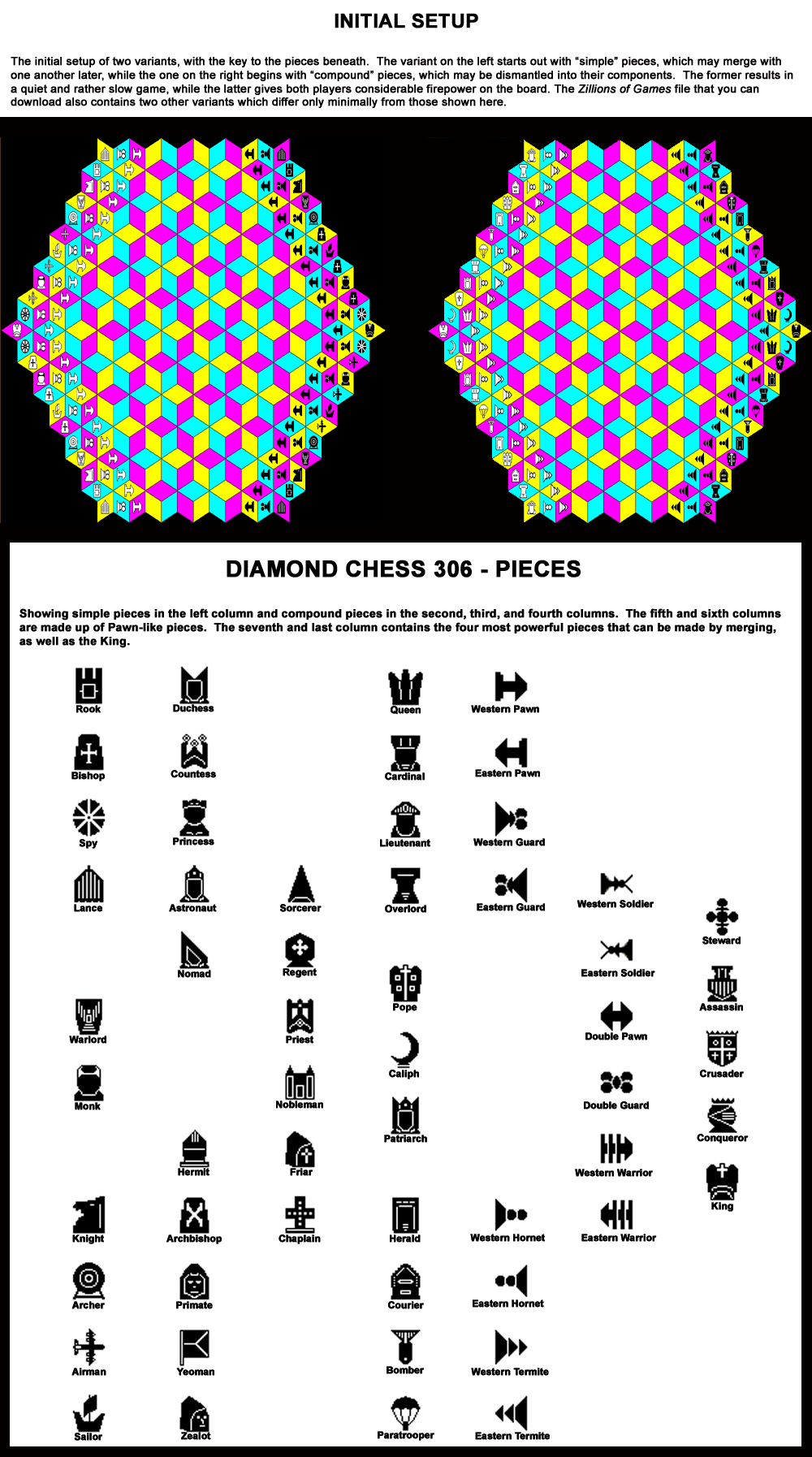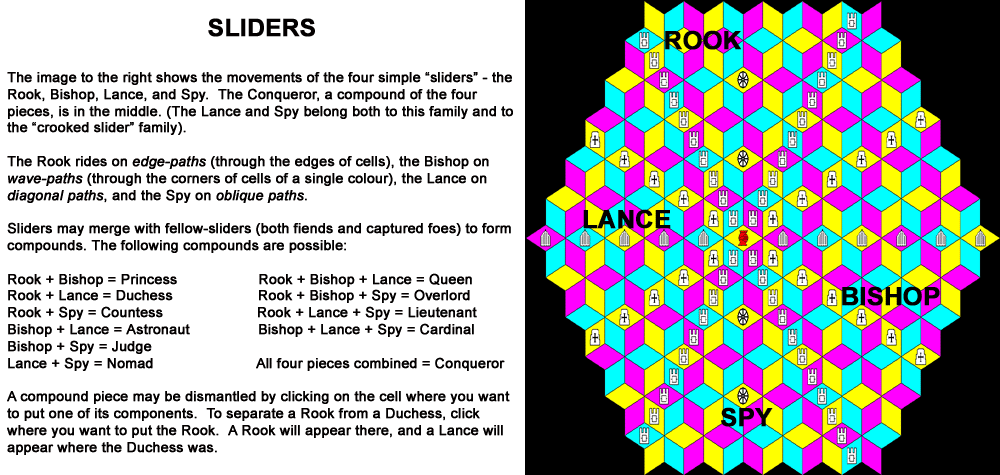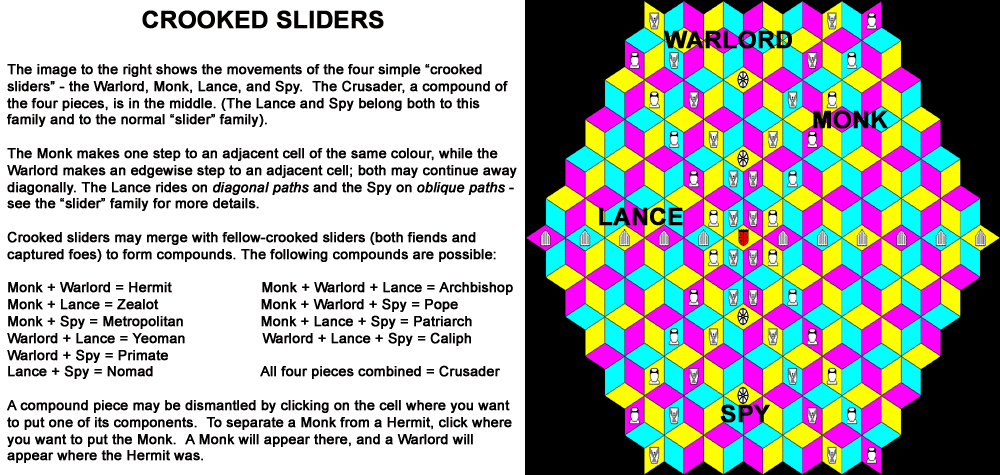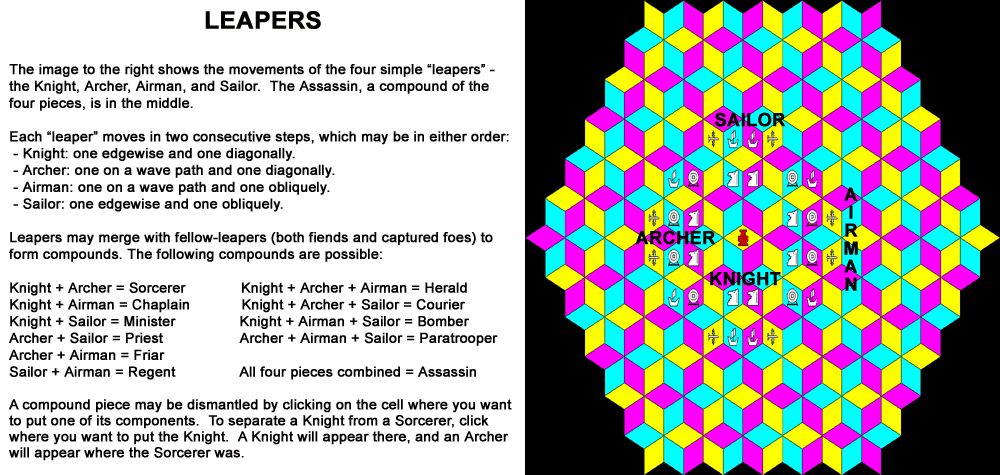Diamond Chess 306
ACKNOWLEDGEMENTS AND MISSION STATEMENT
I have spent about three years working on DIAMOND CHESS 306. It is inspired by Parachess (invented in 2002 by Tony Paletta) and Assimilation Fusion Chess (invented in 2001 by Fergus Duniho). Several years back, I fell in love with the Parachess board and judged it worthy of further exploration. At about the same time, I developed a fascination with a number of Fergus Duniho's games, in which chess pieces may be combined with other pieces (both friends and captured enemies) to create new pieces, which can themselves be disassembled again into their components. So I gratefully acknowledge my debt to Tony Paletta for the design of the board and for many of the pieces, and to Fergus Duniho for the idea of capturing and assimilating the powers of pieces. I have also borrowed a few ideas from Hexagonal Chess.
Setup
I have expanded Tony Paletta's original 72-cell board to 306 cells. In addition to the three paths that he defined (the edge path, diagonal path, and wave path), I have defined an oblique path, which resembles the path taken by a Bishop in many variants of Hexagonal Chess.

Pieces
The pieces used in Diamond Chess 306 come from several different sources:
1. Pieces borrowed from Tony Paletta's Parachess, with names and values unchanged: Rook, Princess, Duchess, Queen, Archer, Knight, Sorcerer, Monk, Warlord, Zealot, Yeoman.
2, Pieces borrowed from Parachess, with names changed : Astronaut (originally called the Bishop; a piece of my own - which is more similar to its FIDE counterpart, is now called the Bishop.
3. Pieces borrowed from Parachess, with values changed : Bishop, Overlord, Lieutenant, Cardinal, King, Pawn
4. Pieces borrowed from Hexagonal Chess, with names changed : Spy (it resembles the BISHOP in many Hexagonal Chess variants).
5. Pieces that I have invented specifically for Diamond Chess 306 : Bishop, Lance, Spy, Countess, Judge, Nomad, Conqueror, Airman, Sailor, Friar, Priest, Chaplain, Minister, Regent, Herald, Courier, Paratrooper, Bomber, Assassin, Metropolitan, Hermit, Primate, Archbishop, Pope, Patriarch, Caliph, Crusader.
Apart from the King (a standalone piece, unable to merge with any other piece), pieces are grouped into four "families" - sliders, leapers, crooked pieces, and pawns. Pieces may merge with other pieces of the same "family" to form more complex pieces, which may subsequently be disassembled into their components. This is done by capturing an enemy piece, whose powers are absorbed by the capturing piece, or by fusing with a friendly piece by moving one piece onto another friendly piece, as though it were an enemy piece. To break a complex piece down into its components, move one component away onto an empty cell. This is done, in the Zillions program, by clicking on an empty cell with the mouse. A simple component on a compound piece will move there, leaving the rest of the piece behind. For example, a Duchess (a combination of the Rook and the Lance) may be divided as follows : clicking on an empty cell along a rook-path from the Lance will create a Rook on the designated cell, leaving a Lance where the Duchess was.
Pieces may merge only with pieces of the same "family." Thus the Duchess (a Rook-Lance compound) is possible, but a Rook-Knight compound is not.
I have taken Fergus Duniho's ideas a step further. In his games, only simple pieces may merge with other simple pieces. I wanted a game that would be a bit wilder, so in Diamond Chess 306, compound pieces may also merge with other compound pieces.





Rules
SPECIAL RULES
 1. When a compound piece is captured by a simple piece which is identical to one of its components, the capturing piece simple absorbs the additional values and is converted into the compound piece. For example, a Rook capturing a Duchess (Rook + Lance) simply absorbs the additional powers of the Lance, converting into a Duchess. Pieces may only absorb the powers of enemy pieces in this way. To allow the above example between friendly pieces would involve sacrificing a Rook. The same principle applies to Rule number 2, below.
1. When a compound piece is captured by a simple piece which is identical to one of its components, the capturing piece simple absorbs the additional values and is converted into the compound piece. For example, a Rook capturing a Duchess (Rook + Lance) simply absorbs the additional powers of the Lance, converting into a Duchess. Pieces may only absorb the powers of enemy pieces in this way. To allow the above example between friendly pieces would involve sacrificing a Rook. The same principle applies to Rule number 2, below.
2. When a compound piece captures another compound piece, it simply absorbs any additional values that the other piece may have. For example, a Duchess (Rook + Lance) capturing a Princess (Rook + Bishop) becomes a Queen.
3. When a compound piece captures a simple piece, the latter is simply killed and removed from the board.
Notes
 I have programmed a Zillions of Games file to play this game. You may download it here. You need the Zillions of Games engine installed to play it.
I have programmed a Zillions of Games file to play this game. You may download it here. You need the Zillions of Games engine installed to play it.
* Free distribution of this game is permitted - and, in fact, encouraged - for any noncommercial purpose.
* You have Zillions experience? Feel free to optimise the code, correct any bugs, create variants for this game, or even use ideas (including code) from this program in games of your own. You may email me
with suggestions. If I use your suggestions in future editions, I will acknowledge you.
 This 'user submitted' page is a collaboration between the posting user and the Chess Variant Pages. Registered contributors to the Chess Variant Pages have the ability to post their own works, subject to review and editing by the Chess Variant Pages Editorial Staff.
This 'user submitted' page is a collaboration between the posting user and the Chess Variant Pages. Registered contributors to the Chess Variant Pages have the ability to post their own works, subject to review and editing by the Chess Variant Pages Editorial Staff.
By David Cannon.
Web page created: 2009-02-04. Web page last updated: 2010-06-26






 This 'user submitted' page is a collaboration between the posting user and the Chess Variant Pages. Registered contributors to the Chess Variant Pages have the ability to post their own works, subject to review and editing by the Chess Variant Pages Editorial Staff.
This 'user submitted' page is a collaboration between the posting user and the Chess Variant Pages. Registered contributors to the Chess Variant Pages have the ability to post their own works, subject to review and editing by the Chess Variant Pages Editorial Staff.
 1. When a compound piece is captured by a simple piece which is identical to one of its components, the capturing piece simple absorbs the additional values and is converted into the compound piece. For example, a Rook capturing a Duchess (Rook + Lance) simply absorbs the additional powers of the Lance, converting into a Duchess. Pieces may only absorb the powers of enemy pieces in this way. To allow the above example between friendly pieces would involve sacrificing a Rook. The same principle applies to Rule number 2, below.
1. When a compound piece is captured by a simple piece which is identical to one of its components, the capturing piece simple absorbs the additional values and is converted into the compound piece. For example, a Rook capturing a Duchess (Rook + Lance) simply absorbs the additional powers of the Lance, converting into a Duchess. Pieces may only absorb the powers of enemy pieces in this way. To allow the above example between friendly pieces would involve sacrificing a Rook. The same principle applies to Rule number 2, below.
 I have programmed a Zillions of Games file to play this game. You may
I have programmed a Zillions of Games file to play this game. You may